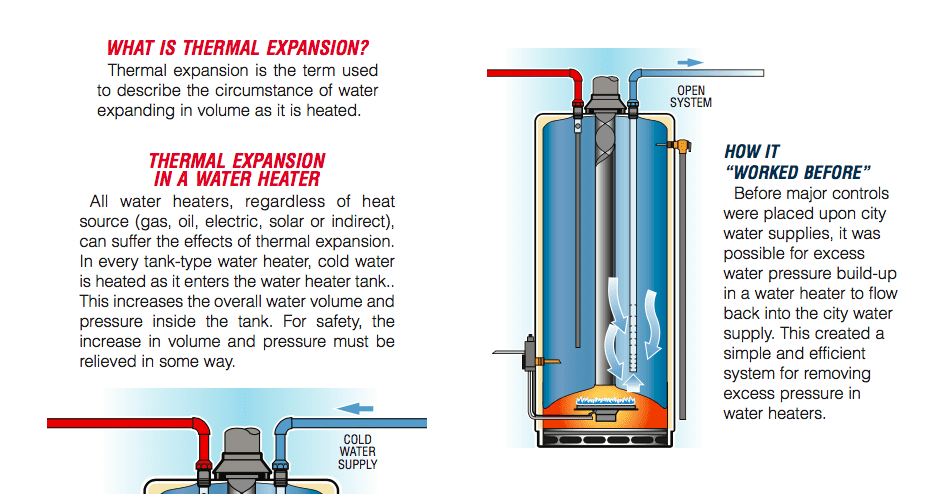Expansion Tanks
Why You Might Need an Expansion Tank
Expansion tanks look like a mini boiler, and typically sit on top of the water heater. They come in many different sizes, depending on your water pressure, the amount of heated water, and the temperature the water is heated to. But why are they important?
Water expands as it is heated, and its’ pressure will increase if there’s no room for thermal expansion. The old plumbing systems were designed so that the expanding water in heaters would push some water back outside the house – into the public water main, which would absorb the pressure. But, this mechanism doesn’t work anymore.

Today’s plumbing systems, however, utilize controls and other devices, such as check valves, for efficiency and comfort, often creating what is called a “closed system”. The purpose of a one-way valve, which prevents back flow of water, is to keep water from flowing back out of the house through the service pipe, preventing a possible contamination to get into the public water supply in the street.
The challenge with check valves is that the water builds up in this closed system until someone opens a valve. If water pressure gets high enough, there’s a high risk of the damage of plumbing fixtures, supply pipes and even the water heater.
Why Should You Install an Expansion Tank?
Tanked water heaters on a closed system – that is, those hooked up to a public water system with a check valve or back flow device – should have an expansion tank installed. Note that an expansion tank is not necessary if you have a tankless water heater (also known as demand-type or instantaneous water heaters) or are on a private well system.
All water heaters, regardless of heat source, can suffer the negative effects of thermal expansion as cold water gets heated, increasing the overall water volume and pressure inside the tank. For safety, the increase in volume and pressure must be relieved.
This is where the expansion tank comes into play: when sized and tuned right and installed correctly, it takes on this “extra” water and minimizes excess pressure.
If your HVAC system does not have a working expansion tank, swings in water pressure can cause leaking or bursting of your water heater tank, as the glass lining of the water heater and other plumbing fixtures and components get damaged.
Expansion tank helps maintain minimal pressure increase during heated water expansion, helps reduce water hammer, and helps protect the plumbing system from stress. To do so, it must be properly located, sized, and tuned. Also, to prevent premature failures, your expansion tank should be checked annually.
Our HVAC technicians make sure each expansion tank is correctly installed, and maintained, to prevent water hammer, high water bills and unnecessary wear on the water heater and plumbing fixtures.
If you have a tank water heater and a check valve or pressure-regulating valve on your water main, then you should consider installing a thermal expansion tank.
At UGI Heating, Cooling and Plumbing, our exceptional team of HVAC contractors and technicians is ready to help make your home safe and comfortable, by delivering HVAC solutions that meet your needs.
Contact us today for more information and to schedule an appointment.
- Service Plans
- Heating
- Cooling
- UGI Advantage
- Plumbing
- Ductless AC & Heat Split Systems
- Geothermal
- Oil to Gas Conversions
- Healthy Home Solutions / Duct Cleaning
- Weatherization
- Fuel Line Installations
- Whole Home Generators
- Air Cleaners, Humidifiers & Other Home Air Quality Products
- Whole House Air Filter Systems
- System Tune-Ups & Maintenance
- System Zoning
- Thermostats & Home Comfort Controls
- Water Treatment
Our Current Specials
Click here to view all coupons/offers >
Call UGI Heating, Cooling & Plumbing today at 1-833-980-3496 to take advantage of this offer.
Click here to Schedule an Appointment >Contact Us
*Required









